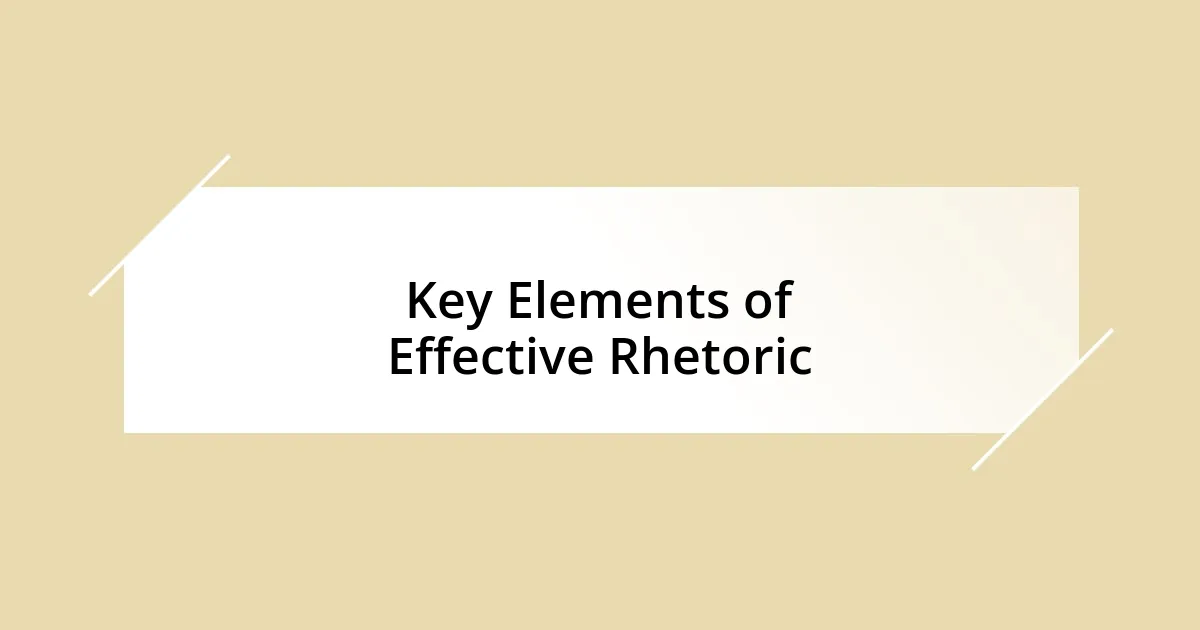Key takeaways:
- Political rhetoric shapes societal values and can motivate action, but it carries the responsibility to balance passion with truthfulness.
- The evolution of rhetoric from Ancient Greece through the digital age highlights its enduring principles and the challenges posed by new media.
- Key elements of effective rhetoric include clarity, emotional appeal, audience awareness, authenticity, and structured arguments to foster connection.
- Developing rhetorical skills involves self-reflection, practice, and seeking feedback to enhance the ability to communicate effectively and authentically.

Understanding Political Rhetoric
Political rhetoric is more than just persuasive speech; it reflects the values, fears, and aspirations of a society. I remember the first time I heard a political leader stir emotions with their words. It was during a heated election, and their passionate delivery felt like a rallying cry, capturing the hopes of so many around me. Isn’t it intriguing how language can mobilize us to action or influence our beliefs?
At times, I find myself pondering the responsibility that comes with political rhetoric. Words have immense power, yet they can also mislead. I recall a speech that used emotional appeals to sway opinions on a controversial issue. It left me wondering: How do we balance passion with truthfulness in our discourse? This question has lingered in my mind, highlighting the fine line between motivating change and perpetuating misinformation.
Furthermore, the context in which rhetoric is delivered can dramatically alter its impact. In a recent political debate, I observed how the candidates’ tones and gestures enhanced their messages. Was it the confidence in their voice or the sincerity in their eyes that resonated more deeply? Personally, I’ve noticed that when I communicate authentically, I connect better with others. This realization has led me to appreciate the craft of rhetoric not merely as a tool for persuasion but as an essential part of human connection.

Historical Context of Political Rhetoric
Throughout history, political rhetoric has been a powerful force, shaping societies and influencing outcomes. Ancient Greece, for example, was a cradle of rhetorical education, with philosophers like Aristotle defining key principles of persuasion. I’ve often thought about how these foundational ideas still resonate today; politicians still employ techniques that Aristotle would recognize, such as ethos (credibility), pathos (emotional appeal), and logos (logical reasoning). Isn’t it fascinating that the core elements of effective rhetoric have endured through the ages?
Moving into the 20th century, we saw rhetoric evolve significantly with the advent of mass media. I vividly recall learning about figures like Franklin D. Roosevelt, whose radio addresses during the Great Depression, known as “Fireside Chats,” created an intimate connection with millions. It’s a striking example of how the medium can shape the rhetoric itself. In my own experience, I’ve found that the way we deliver messages—whether through text, speech, or social media—impacts how they are perceived.
Fast forward to today, the digital age brings both challenges and opportunities for political rhetoric. Social media platforms act as double-edged swords, amplifying voices but also spreading misinformation. I often reflect on how tweets or short videos can ignite movements yet also confuse narratives. What’s clear is that the historical evolution of rhetoric informs our current landscape, reminding us to be both thoughtful and critical in our consumption and production of political discourse.
| Period | Significant Development |
|---|---|
| Ancient Greece | Foundational principles of rhetoric established by thinkers like Aristotle. |
| 20th Century | Rise of mass media; FDR’s “Fireside Chats” exemplified intimate political communication. |
| Digital Age | Social media amplifies rhetoric, increasing both access and the potential for misinformation. |

Key Elements of Effective Rhetoric
Key elements of effective rhetoric revolve around clarity, audience awareness, and emotional resonance. Reflecting on my own experiences, I often find that speeches that are straightforward and relatable are the most impactful. I remember attending a town hall meeting where the speaker not only articulated their ideas clearly but also made an earnest effort to understand the audience’s concerns. This connection transformed the gathering from a mundane event into a shared experience, demonstrating how effective rhetoric can create a sense of community.
Here are the key elements that underpin successful rhetoric:
- Clarity: The message must be easily understood, avoiding jargon that could alienate the audience.
- Emotional Appeal: Engaging the audience’s feelings can drive home a point more effectively than mere facts.
- Audience Awareness: Tailoring the message to the interests and values of the audience increases relevance and connection.
- Authenticity: Genuine delivery resonates more profoundly, creating trust and fostering a bond with listeners.
- Structured Arguments: A well-organized speech helps guide the audience through the points being made, making the argument more compelling.
In another instance, I witnessed a debate where a candidate’s calm demeanor amid heated exchanges drew viewers in. The way they articulated their policies not only highlighted their expertise but also evoked empathy, and it struck me how effective rhetoric can sometimes simply lie in the ability to listen and respond sincerely. This experience reinforces my belief that a great speaker is often as much about understanding others as it is about sharing one’s own message.

Analyzing Rhetorical Strategies in Speeches
Analyzing rhetorical strategies in speeches involves dissecting how speakers craft their messages to connect with their audience. I recall a campaign speech that stuck with me; the candidate began with a poignant personal story that established an emotional anchor. This technique not only drew in the audience but also set the stage for deeper discussions about community values and shared experiences. Isn’t it interesting how a simple narrative can pave the way for complex political themes?
Another effective strategy is the use of repetition. I’ve noticed this often in passionate speeches, where key phrases are reiterated to create emphasis and urgency. For example, during a local rally, a speaker repeated the phrase “together we rise” several times, which fostered a sense of unity and purpose. It made me think about how effective rhetoric isn’t just about delivering information; it’s about inspiring action and collective identity among listeners.
Lastly, the balance of ethos, pathos, and logos is crucial in compelling rhetoric. I remember a talk where the speaker expertly wove together logical facts with emotional appeals and established credibility by sharing their own relevant background. This blend left the audience not just informed, but moved to consider new perspectives. In my view, an effective speech is like a well-crafted story—it resonates, engages, and challenges the audience to think differently. How often do we encounter speeches that manage to do all three successfully?

Evaluating Rhetoric in Contemporary Politics
Evaluating the rhetoric in contemporary politics is like peeling back the layers of an onion; the deeper you go, the more you uncover. I recently attended a political rally where one candidate used humor to diffuse tensions—it was a strategic move that left the audience laughing and engaged. This approach showcased how powerful a well-placed joke can be in breaking down barriers and making complex issues feel more accessible.
I’ve observed that some politicians rely heavily on fear-based rhetoric, which can be compelling but often leads to division rather than unity. I remember listening to a speech that painted a dire picture of the future, and while it grabbed attention, it felt disingenuous. This made me wonder: is scaring people into action truly effective, or does it just breed cynicism and distrust? From my experience, fostering hope can be a much stronger motivator.
Moreover, I’ve realized that the effectiveness of rhetoric also hinges on the delivery. During a recent town hall, a candidate’s passionate yet calm demeanor captivated the crowd, making me reflect on the weight of body language and tone. That evening, I left with a sense of connection—not just to the candidate, but to a collective vision for the community. Isn’t it fascinating how much can be communicated beyond just the words spoken?

Developing Your Own Rhetorical Skills
Enhancing your rhetorical skills begins with self-reflection on your unique voice and style. I remember a time when I struggled to find the right words during a debate, realizing that authenticity mattered more than perfection. This revelation prompted me to embrace my quirks and communicate from the heart, which ultimately resonated more with my audience. How often do we underestimate the power of being genuine?
It’s also vital to practice different rhetorical techniques. I often rehearse speeches in front of a mirror, experimenting with pauses and intonation. There’s something about visualizing the audience’s reactions that helps me refine my delivery. Have you ever noticed how a cleverly timed pause can amplify a message? It’s a simple yet effective strategy that can change the entire tone of your speech.
Moreover, actively seeking feedback plays a crucial role in developing these skills. After presenting a project at work, I welcomed constructive criticism from colleagues. Their insights revealed blind spots I hadn’t considered, allowing me to improve for next time. Engaging with your audience, whether in formal settings or casual conversations, can reveal nuances that sharpen your rhetorical approach. Isn’t it fascinating how each interaction can teach us something new?














